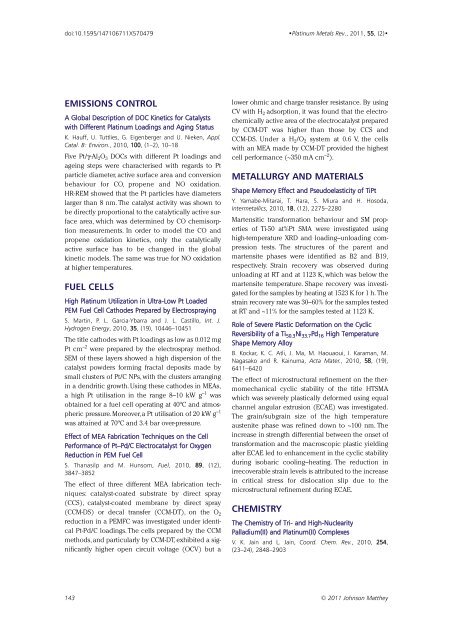Download - Platinum Metals Review
Download - Platinum Metals Review
Download - Platinum Metals Review
You also want an ePaper? Increase the reach of your titles
YUMPU automatically turns print PDFs into web optimized ePapers that Google loves.
doi:10.1595/147106711X570479<br />
•<strong>Platinum</strong> <strong>Metals</strong> Rev., 2011, 55, (2)•<br />
EMISSIONS CONTROL<br />
A Global Description of DOC Kinetics for Catalysts<br />
with Different <strong>Platinum</strong> Loadings and Aging Status<br />
K. Hauff, U. Tuttlies, G. Eigenberger and U. Nieken, Appl.<br />
Catal. B: Environ., 2010, 100, (1–2), 10–18<br />
Five Pt/γ-Al 2 O 3 DOCs with different Pt loadings and<br />
ageing steps were characterised with regards to Pt<br />
particle diameter, active surface area and conversion<br />
behaviour for CO, propene and NO oxidation.<br />
HR-REM showed that the Pt particles have diameters<br />
larger than 8 nm. The catalyst activity was shown to<br />
be directly proportional to the catalytically active surface<br />
area, which was determined by CO chemisorption<br />
measurements. In order to model the CO and<br />
propene oxidation kinetics, only the catalytically<br />
active surface has to be changed in the global<br />
kinetic models. The same was true for NO oxidation<br />
at higher temperatures.<br />
FUEL CELLS<br />
High <strong>Platinum</strong> Utilization in Ultra-Low Pt Loaded<br />
PEM Fuel Cell Cathodes Prepared by Electrospraying<br />
S. Martin, P. L. Garcia-Ybarra and J. L. Castillo, Int. J.<br />
Hydrogen Energy, 2010, 35, (19), 10446–10451<br />
The title cathodes with Pt loadings as low as 0.012 mg<br />
Pt cm –2 were prepared by the electrospray method.<br />
SEM of these layers showed a high dispersion of the<br />
catalyst powders forming fractal deposits made by<br />
small clusters of Pt/C NPs, with the clusters arranging<br />
in a dendritic growth. Using these cathodes in MEAs,<br />
a high Pt utilisation in the range 8–10 kW g –1 was<br />
obtained for a fuel cell operating at 40ºC and atmospheric<br />
pressure.Moreover,a Pt utilisation of 20 kW g –1<br />
was attained at 70ºC and 3.4 bar over-pressure.<br />
Effect of MEA Fabrication Techniques on the Cell<br />
Performance of Pt–Pd/C Electrocatalyst for Oxygen<br />
Reduction in PEM Fuel Cell<br />
S. Thanasilp and M. Hunsom, Fuel, 2010, 89, (12),<br />
3847–3852<br />
The effect of three different MEA fabrication techniques:<br />
catalyst-coated substrate by direct spray<br />
(CCS), catalyst-coated membrane by direct spray<br />
(CCM-DS) or decal transfer (CCM-DT), on the O 2<br />
reduction in a PEMFC was investigated under identical<br />
Pt-Pd/C loadings. The cells prepared by the CCM<br />
methods, and particularly by CCM-DT, exhibited a significantly<br />
higher open circuit voltage (OCV) but a<br />
lower ohmic and charge transfer resistance. By using<br />
CV with H 2 adsorption, it was found that the electrochemically<br />
active area of the electrocatalyst prepared<br />
by CCM-DT was higher than those by CCS and<br />
CCM-DS. Under a H 2 /O 2 system at 0.6 V, the cells<br />
with an MEA made by CCM-DT provided the highest<br />
cell performance (~350 mA cm –2 ).<br />
METALLURGY AND MATERIALS<br />
Shape Memory Effect and Pseudoelasticity of TiPt<br />
Y. Yamabe-Mitarai, T. Hara, S. Miura and H. Hosoda,<br />
Intermetallics, 2010, 18, (12), 2275–2280<br />
Martensitic transformation behaviour and SM properties<br />
of Ti-50 at%Pt SMA were investigated using<br />
high-temperature XRD and loading–unloading compression<br />
tests. The structures of the parent and<br />
martensite phases were identified as B2 and B19,<br />
respectively. Strain recovery was observed during<br />
unloading at RT and at 1123 K, which was below the<br />
martensite temperature. Shape recovery was investigated<br />
for the samples by heating at 1523 K for 1 h. The<br />
strain recovery rate was 30–60% for the samples tested<br />
at RT and ~11% for the samples tested at 1123 K.<br />
Role of Severe Plastic Deformation on the Cyclic<br />
Reversibility of a Ti 50.3 Ni 33.7 Pd 16 High Temperature<br />
Shape Memory Alloy<br />
B. Kockar, K. C. Atli, J. Ma, M. Haouaoui, I. Karaman, M.<br />
Nagasako and R. Kainuma, Acta Mater., 2010, 58, (19),<br />
6411–6420<br />
The effect of microstructural refinement on the thermomechanical<br />
cyclic stability of the title HTSMA<br />
which was severely plastically deformed using equal<br />
channel angular extrusion (ECAE) was investigated.<br />
The grain/subgrain size of the high temperature<br />
austenite phase was refined down to ~100 nm. The<br />
increase in strength differential between the onset of<br />
transformation and the macroscopic plastic yielding<br />
after ECAE led to enhancement in the cyclic stability<br />
during isobaric cooling–heating. The reduction in<br />
irrecoverable strain levels is attributed to the increase<br />
in critical stress for dislocation slip due to the<br />
microstructural refinement during ECAE.<br />
CHEMISTRY<br />
The Chemistry of Tri- and High-Nuclearity<br />
Palladium(II) and <strong>Platinum</strong>(II) Complexes<br />
V. K. Jain and L. Jain, Coord. Chem. Rev., 2010, 254,<br />
(23–24), 2848–2903<br />
143 © 2011 Johnson Matthey
















